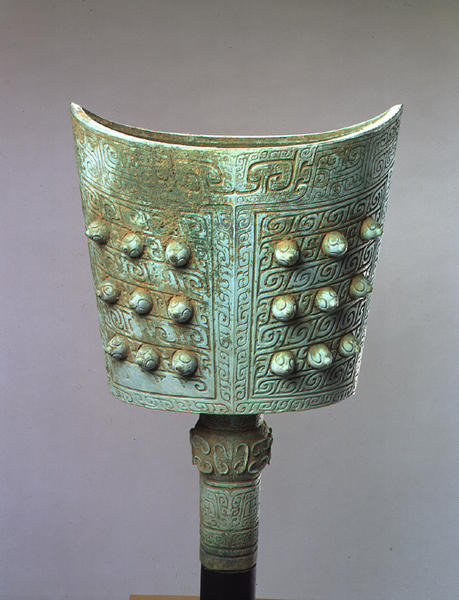Shanked Bell: Nao
- China, southern regional Bronze
- Age culture, about 1400-1000 BCE
- Bronze
- height 73.4 cm, depth 35cm, width 50 cm
It is impossible to guess what sounds may have enriched the ceremonial banquets of early Bronze Age centers in Henan province in north China: the only musical instruments that have survived with the buried vessels are small bronze hand bells, sometimes discovered in graduated sets of three or five.1 This differs sharply from the south, where Chinese archaeologists are discovering distinctive bronze-using cultures marked by a preference for large percussive instruments, chiefly bells.2 Typically found singly in isolated burials devoid of human remains, however, these southern bells are ironically mute about their specific function in ancient southern Chinese society.
An impressive example of its type, the massive Shumei nao bell3 was made to stand mouth up, its hollow shank designed for support. As with the diminutive hand-held examples that may be its distant inspiration, the Shumei bell lacks a clapper and must have been played with mallets. The bell is not round but lens-shaped in cross-section, like many of the earliest Chinese bronzes found at Erlitou. Objects of this shape, when struck, produce not one but two primary vibration patterns, allowing them to emit more than one note.4 Fully exploited in later Bronze Age times, this property ultimately encouraged the creation of large bell sets intended to be played harmonically in ensembles with other instruments such as winds and strings.5
The southern bronze-casters responsible for the Shumei bell were familiar with northern bronzes but felt free to transform their models. First, they made an instrument that was exponentially larger than any of the surviving bells from Henan. Second, they transformed the mask and dragon designs so prevalent on northern creations. Vestiges of those motifs are limited to the borders of the bell, with cusped elements of the face appearing at the top of the cavity (corresponding with the striking zone) as well as on the shank below. Swirling patterns derived from dragons flank the reconfigured mask at the lip. In addition, the ranks of symmetrically arranged knobs may have been inspired by the pairs of staring eyes that dominate northern masks, while the tracery of barbed coils framing the knobs recall the tight spirals that commonly texture the ground of northern castings. Virtually unique among surviving examples, this bell is also ornamented on the interior.6
Three other bells, all excavated in the past few decades south of the lower Yangzi River basin in Zhejiang and northern Fujian provinces, resemble the Shumei example.7 All appear to have been produced at roughly the same time, perhaps at the same foundry. Southern bronze-casters knew northern casting methods and followed them in their work. The junctions between the four-part assembly of the piece-molds used to cast the Shumei nao bell are still visible along the central axis of the two broad faces and along the two vertical edges, and continue down the shank. The undecorated passage at the lower left of the cavity reflects damage to the relief motifs ornamenting that portion of the clay mold during the casting process.
- Although the earliest datable hand bell set was found in the early Anyang period Tomb 5 (see Yinxu Fu Hao Mu 1980, p. 100, pl. 62.1), the type likely predates the Anyang period. In fact, as Robert Bagley has suggested, the massive southern bells best reflect pre-Anyang styles; see Bagley 1987, p. 57, n.129.
- Bagley 1987, 34.
- The use of this Chinese term is conventional; as no such bell is self-named in an inscription, it is impossible to know what they may have been called at the time and place of their manufacture.
- The acoustics of the Shumei bell have been tested and analyzed. Two tones are produced when the bell is struck at different points near the rim, one, at the center of a long side (the sui tone); the second, two-thirds of the way to the edge (gu tone). The sui tone is a major second below the gu tone. See Falkenhausen, Hiller, and Weninger, forthcoming.
- See Falkenhausen 1993.
- The subjects of the decoration remain unclear due to burial accretions, but the execution of the large, unframed designs differs from the intaglio and relief patterns on the exterior. The only other known example is a southern nao in the Metropolitan Museum (no. 42.24.2); a rubbing of its interior decor is published in Rawson 1990, vol. 2B, p. 734, fig. 124.2.
- Two of the bells come from Chengxing, Zhejiang; see Wenwu 1960.7, pp. 48-49, and Wenwu 1973.1, p. 62. The third, from Jian’ou, Fujian, was first published in Wenwu 1980.11, p. 95. It is difficult to date these three bells–and also the Shumei example–with precision. Based on typology and style, they fall mid-way in a developmental sequence beginning in roughly 1500 B.C. and ending in about 950 B.C.
